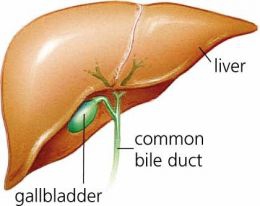Cholecystitis can be a very miserable condition. This is inflammation of the gallbladder usually in response to gallstones. The gallbladder is part of the digestive system that distributes bile from the liver into the digestive tract. Over time stones build up and block the opening causing inflammation and severe pain. Acalculous cholecystitis is inflammation of the gallbladder without stones being present.
Symptoms of cholecystitis include fever, sudden sharp abdominal pain on the upper right side, nausea, vomiting, and unable to take in food or fluids. The skin or whites of the eyes may turn yellow due to blockage of the liver ducts.
This is a medical emergency and should be evaluated immediately. This article will help you understand Acalculous cholecystitis, how to recognize acute Acalculous cholecystitis and what to do about it.

What Is Acalculous Cholecystitis?
Cholecystitis is a pretty common condition affecting 10 to 20% of people in the United States. Most cases of cholecystitis are seen in females, but men seem to suffer from higher rates of Acalculous cholecystitis. Acalculous cholecystitis is a rare type of cholecystitis that comes on in response to something other than gallstones. It occurs in about 2 to 15% of all people with cholecystitis. Acalculous cholecystitis is an inflamed gallbladder without the presence of gallstones.
Cases of acute Acalculous cholecystitis are usually triggered by abdominal surgery in the region of the gallbladder that causes it to be inflamed. Trauma, burns, and infection can also cause the gallbladder to become inflamed. It has also been seen in patients that are severely malnourished or AIDS sufferers.
The highest rates of Acalculous cholecystitis (about 80%) appear in men after open heart surgery, bone marrow transplantation, or hospitalization for a critical illness.
Symptoms of Acalculous Cholecystitis
The symptoms include:
Nausea (most common symptom)
May or may not have pain in upper right abdomen
Tenderness to touch right upper abdomen
Fever
High white blood cell count (showing infection)
Elevated liver blood tests
Elevated pancreas enzymes (digestive enzymes)
Acalculous Cholecystitis Treatment
Medical Management
Medical management of this condition can only relieve the symptoms. Pain medications can be given to relieve pain and fever. Your doctor may choose to give you intravenous antibiotics prior to surgery for any infection you may have or to prevent infection after surgery.
Surgery
If you have Acalculous cholecystitis, you will be referred to a surgeon to remove your gallbladder. This is the best way to bring permanent relief from the condition. Surgery is usually done laparoscopically within 24 hours of the initial attack to prevent sepsis (whole body infection) and other complications.
Laparoscopic “Lap Chole” is a minimally invasive surgery where they make tiny incisions in your abdomen and insert a scope. They locate the gallbladder and remove it through the tiny incisions. The doctor can also inject a dye “cholangiography” into the biliary tract to check for the presence of any gallstones or malformation in the tract that may have caused the episode. Any repairs can be done via the scope during surgery.
Surgery results in about a 96% cure rate. Your doctor will want you to follow up in 2 to 4 weeks after your surgery to make sure you are healing well. The recovery is very easy if your surgery is done laparoscopically.
In more severe cases where infection has spread to the abdomen or the gallbladder is severely inflamed, your doctor may need to do an open cholecystectomy. This is where they remove your gallbladder through an open incision. They may also rinse out your abdomen to remove infectious drainage and place a drain in your side after the incision is closed to allow any pus to continue to drain. Recovery from open cholecystectomy can take up to 6 to 8 weeks.
Diet
Since alcalculous cholecystitis is a digestive disorder, during acute Acalculous cholecystitis, your doctor will most likely not allow you to have anything to eat by mouth. You will be put on IV fluids to keep you hydrated.
Once the attack subsides, you will be put on a low-fat diet. This is because the gallbladder is crucial in helping your body digest fat and eating fat can stimulate another gallbladder attack. Try to eat a diet low in saturated fats including lean meats (chicken, turkey, and fish) low or fat-free dairy, and reduce amounts of butter, mayonnaise, and creamy salad dressings. Check your labels for any processed or canned foods.
Increase your intake of fiber to help your body digest fats better. Include plenty of whole grain bread, legumes, fresh fruits and vegetables. This helps bind any fats and reduces the work of your gallbladder.
Acute Calculous Cholecystitis vs. Acalculous Cholecystitis
This table will help you differentiate between acute cholecystitis caused by gallstones (calculous) and Acalculous cholecystitis that is not directly caused by gallstones:
Symptom | Acute Calculous Cholecystitis | Acalculous Cholecystitis |
Abdominal Pain | Yes | Sometimes |
Fever | Low-grade | High |
Abdominal Distention | Rare | Yes |
Nausea/Vomiting | Yes | Sometimes |
Jaundice | Yes | Sometimes |
Presence of Stones | Yes | No |
A Few Notes
Calculous cholecystitis isn’t always acute and can become a chronic condition until the gallbladder is removed. Gallbladder attacks tend to come in waves and can go away for up to months at a time only to return suddenly after eating a high-fat meal.
Since having gallstones would be a definite diagnosis of calculous cholecystitis, it is much easier to place signs and symptoms together and start treatment right away. Acalculous cholecystitis is much harder to diagnose and can often cause critical illness because of a delay in treatment.
When cholecystitis is “acalculous” it is somewhat of a medical mystery as to why the gallbladder becomes inflamed. It most often happens in the intensive care unit when people are critically ill. For this reason, other illness symptoms may mask the inflamed gallbladder symptoms and the diagnosis can be hard to make.

View All Comments /Add Comment